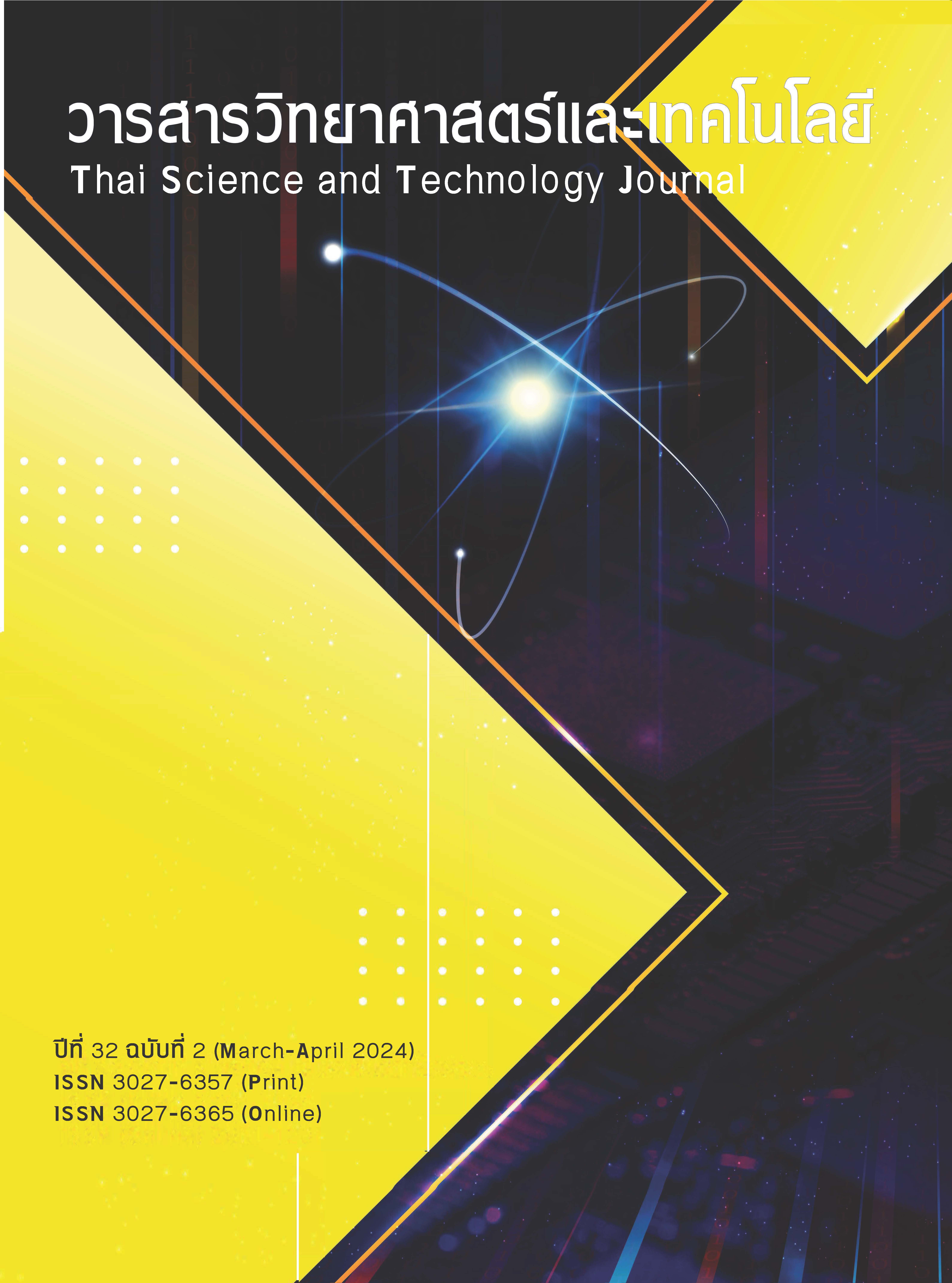Development of Paper Soap Product for Hand Sanitizer Containing Hevea brasiliensis Leaves Extract
Main Article Content
Abstract
Objectives: To 1) develop paper soap product for hand sanitizer containing Hevea brasiliensis leaves extract 2) investigate skin irritation in volunteers, and 3) study satisfaction with the paper soap product. Methods: H. brasiliensis leaf extract was mixed with chemicals to produce a hand-washing paper soap product. The physical, chemical and stability of the soap were tested. Skin irritation was assessed in 30 healthy volunteers, and satisfaction with the test product was evaluated in 129 volunteers. Results: The liquid soap contains the following ingredients: H. brasiliensis extract (4.0%), propylene glycol (3.0%), palm kernel oil (25.0%), potassium hydroxide (5.0%), salt (4.5%), essential oil (2.0%), and distilled water (56.5%). The liquid soap is dark brown, clear, with no sediment, having a viscosity of 3777.65±465.6 mPa S, bubble volume of 90.00±5.00 mL, pH of 8.89 ± 0.28, total fat content of 5.53 ± 0.74 %(w/w), and insoluble in ethanol 0.28 ± 0.11 %(w/w). No skin irritation was found in the subjects. Paper soap products were distributed in packaging boxes to 129 volunteers, 109 females and 20 males. The volunteers expressed satisfaction with the packaging design overall at a good level (average was 4.30 ± 0.62). Simultaneously, their satisfaction with paper soap products in terms of product characteristics was also at a good level, with an average value of 4.22 ± 0.58. Regarding product quality, the volunteers expressed satisfaction at a good level, with a mean of 3.93 ± 0.69. Suggestions included the desire for paper soap to produce more bubbles, add more scents, and adding more usable colors. Conclusion: Paper soap products for hand washing containing crude H. brasiliensis leaf extract were developed as an alternative for the general public. It also adds value to natural leftover rubber leaves and serves as a prototype for further industrial production.
Article Details
References
Sumalee, N., 2014. From "Latex" to "Rubber Products". PSU Knowledge Series, Volume 2. Songkhla, Thailand: Research and Development Office, Prince of Songkhla University; 2014. (in Thai)
Puangthong, J., Daengkanit, A., 2021. Rubber situation in 2020 and trend in 2021. Para rubber electronic bulletin, 42(2); 44-47. (in Thai)
Chaliewchalad, P., Tongphueak, D., Development of hand sanitizer containing Hevea brasiliensis (A. Juss) Muell. Arg. Leaves extract against the growth of some pathogenic bacteria. Chanthaburi, Thailand: Rambhai Barni Rajabhat University; 2018. (in Thai)
Singh, SK., Kumar, SS., 2015. Phytochemical and antibacterial efficacy of Hevea brasiliensis. Journal of Chemical and Pharmaceutical Research, 7(12): 777-783.
Daruliza, KM., Lam, KL., Yang, KL., Priscilla, JT., Sunderasan, E., Ong, MT., 2011. Anti-fungal effect of Hevea brasiliensis latex C-serum on Aspergillus niger. European Review for Medical and Pharmacological Sciences, 15(9): 1027-1033.
Chaikulab, P., Lourithab, N., Kanlayavattanakulab, M., 2017. Antimelanogenesis and cellular antioxidant activities of rubber (Hevea brasiliensis) seed oil for cosmetics. Industrial Crops and Products, 108(1); 56-62.
Zain, WZWM., Ramli, NNB., Jusoh, S., Hamid, NAB., 2021. Antioxidant activity, total phenolic and flavonoid content of Hevea brasiliensis clone. Journal of Academia, 9(1): 1-7.
Salimon, J., Abdullah, BM., Salih, N., 2012. Rubber (Hevea brasiliensis) seed oil toxicity effect and linamarin compound analysis. Lipids in Health and Disease, 11(74); online.
Prakobmee, A., Isarangkool, Na Ayutthaya S., Techawongstien, S., 2014. Effect of leaves age and leaves position on macronutrients in leaves of rubber tree clone RRIM 600. Khon Kaen Agriculture Journal, 57(1): 180-185. (in Thai)
Boonnaum, P., Kabae, N., Hayeemasalaeh, R., Mard-e, W., Suwannarat, P., Noipha, K., 2021. Phytochemical study, total phenolic, and antioxidant activity of Boesenbergia pandurata holtt extract for development of paper hand soap. Research and Development Health System Journal, 14(3): 152-165. (in Thai)
Thai Industrial Standards Institute. Thai Industry Standard Liquid Soap (TIS 1403-2008) [Online]. 2023 March 15 [cited 2023 March 15]. Available from: http://www.fio.co.th/web/tisi_fio/fulltext/TIS1403-2551.pdf (in Thai)
Thai Industrial Standards Institute. Community Product Standards Liquid Soap (TCPS 95-2009) [Online]. 2023 March 15 [cited 2023 March 15]. Available from: http://tcps.tisi.go.th/pub/tcps95_52.pdf (in Thai)
Phinit, J., Techasathien, L., Porasuphatana, S., 2019. Allergic contact dermatitis testing of resin of Dipterocarpus alatus Roxb. ex G. Don on human skin in healthy volunteers. Isan Journal of Pharmaceutical Sciences, 15(2): 129-134. (in Thai)
Suwannarat, W., Achariyakul, M., Itharat, A., Kiettinun, S., 2012. A clinical study phase I on safety of Thai medicinal formula “Benjalokawichien (Ha-Rak)” and each plant component extract. Thammasat Medical Journal, 12(4): 767-776. (in Thai)
Hannuksela, M., Salo, H.,1986. The repeated open application test (ROAT). Contact Dermatitis, 14(4): 221-227.
Chaichanawirote, U., Vantum, C., 2019. Evaluation of content validity for research instrument. Journal of Nursing and Health Sciences, 13 (4): 105-111. (in Thai)
Pornpanawan, T,. Customer satisfaction in fast food customer. Bangkok, Thailand: Thammasat University; 2013. (in Thai)
Lee, N., Lee, J., 2021. Comparison of home use tests with differing time and order controls. Foods, 10, 1275. https://doi.org/10.3390/ foods10061275.
Thansuwan, B., et al. Product development of soap from arabica coffee grounds (Dong Mafai), Makluea Mai Sub-district, Sung Noen District, Nakhon Ratchasima Province. Nakhon Ratchasima, Thailand: Nakhon Ratchasima Rajabhat University; 2016. (in Thai)
Neelapong, W., Phonyotin, B., Sittikiyotin, W., 2018. Extraction of active compounds from Thai herbs: Steam distillation and solvent extraction. The Journal of King Mongkut's University of Technology North Bangkok, 28(4): 901-910. (in Thai)


